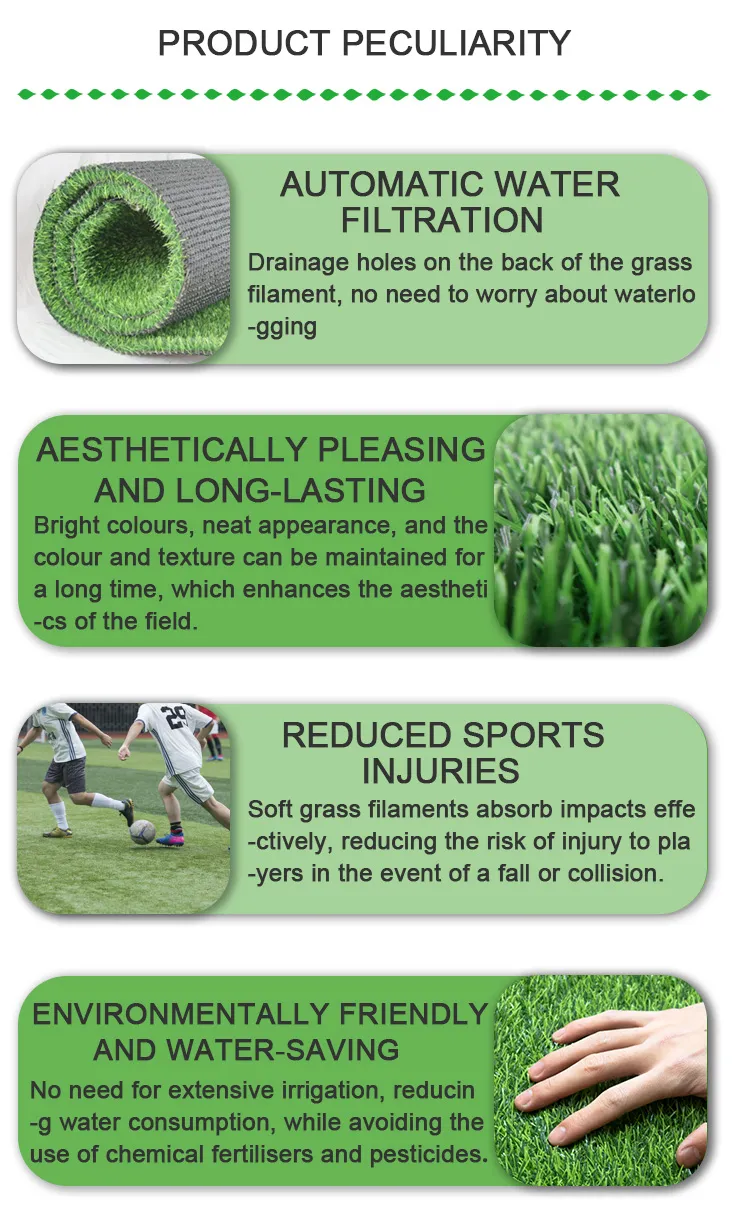
- Afrikaans
- Arabic
- Belarusian
- Bengali
- Czech
- Danish
- Dutch
- English
- Esperanto
- Estonian
- Finnish
- French
- German
- Greek
- Hindi
- Hungarian
- Icelandic
- Indonesian
- irish
- Italian
- Japanese
- kazakh
- Rwandese
- Korean
- Kyrgyz
- Lao
- Latin
- Latvian
- Malay
- Mongolian
- Myanmar
- Norwegian
- Persian
- Polish
- Portuguese
- Romanian
- Russian
- Serbian
- Spanish
- Swedish
- Tagalog
- Tajik
- Thai
- Turkish
- Turkmen
- Ukrainian
- Urdu
- Uighur
- Uzbek
- Vietnamese
turf grass for homes
Dec . 05, 2024 15:15 Back to list
Turf Grass for Homes Creating the Perfect Lawn
A lush green lawn is often considered a hallmark of a well-maintained home. Beyond its aesthetic appeal, turf grass serves a variety of functions, including providing a recreational space, improving air quality, and enhancing property value. With so many varieties to choose from, understanding how to select and maintain the right type of turf grass for your home is essential to creating a vibrant outdoor space.
Understanding Turf Grass Varieties
Turf grass is broadly classified into two categories cool-season grasses and warm-season grasses. Cool-season grasses, such as Kentucky bluegrass and fescue, thrive in the northern regions where temperatures are moderate. They typically grow best during the spring and fall. On the other hand, warm-season grasses, such as Bermuda and Zoysia, are ideal for southern climates, flourishing in the heat of summer and going dormant in cooler months.
Choosing the right variety begins with evaluating your local climate, soil type, and intended use for the lawn. For example, if you live in an area with long winters and short summers, cool-season grass will be more suitable. Conversely, if you reside in a place with hot summers and mild winters, opt for warm-season varieties.
Factors to Consider When Selecting Turf Grass
1. Climate and Region The first step in selecting turf grass is to understand your local climate. Research which grasses thrive in your area and their requirements.
2. Sunlight Exposure Different turf grasses have varying tolerances to sunlight. Consider the amount of sun your lawn receives daily. Some grasses, like Bermuda, require full sun, while shade-tolerant varieties like fine fescue can thrive in partially shaded areas.
3. Soil Type Conducting a soil test can provide valuable information about pH and nutrient levels. Most turf grasses prefer well-draining soils. If your soil is clay-heavy, you might want to consider amending it with organic matter to improve drainage.
4. Foot Traffic If your lawn will be subject to heavy foot traffic, such as with children playing or pets running around, you should select a more durable grass type. Kentucky bluegrass is a popular choice for high-traffic areas due to its resilience.
turf grass for homes

5. Maintenance Requirements Each type of turf grass has different maintenance needs, including watering, mowing height, and fertilization frequency. Assess how much time and effort you are willing to devote to lawn care.
Establishing Your Lawn
Once you have chosen the right turf grass for your home, the next step is to establish the lawn. You can either sow grass seed or lay sod, depending on your preferences and budget.
Seeding This method is more economical and allows for a greater variety of grass types. When seeding, ensure proper soil preparation, including tilling and leveling the ground. Spread the seeds evenly and cover them lightly with soil. Water the area thoroughly to kickstart germination.
Sodding Though more costly, laying sod provides immediate results and is ideal for quick landscape transformation. Choose high-quality sod from a reputable supplier, ensuring it is freshly cut and kept moist until installation. Lay the pieces in a staggered pattern and press them firmly into the soil to eliminate air pockets.
Caring for Your Lawn
After establishing your lawn, care is vital to maintaining its health. Regular mowing is essential, as it encourages lateral growth and helps to prevent weeds. Keep your mower blades sharp and set at the appropriate height for your grass type. Over time, regular mowing contributes to a dense and lush lawn.
Watering is another critical aspect. Generally, turf grass requires about one inch of water per week, whether from rainfall or irrigation. Early morning is the best time to water, allowing the grass to absorb moisture before temperatures rise.
Finally, fertilization is important for promoting growth and color. A balanced fertilizer can be applied based on the grass type and soil nutrient levels. Always follow manufacturer guidelines to avoid over-fertilization, which can harm the lawn.
In conclusion, turf grass offers a multitude of benefits for homeowners, from aesthetic enhancement to ecological improvements. By carefully selecting the right variety, establishing it correctly, and providing proper maintenance, you can create a thriving lawn that enhances both your outdoor space and your quality of life.
-
The Benefits of Artificial Turf for Indoors
NewsJul.15,2025
-
How Artificial Grass Suppliers Ensure Quality Products
NewsJul.15,2025
-
Artificial Grass and Pets: A Space for Relaxation
NewsJul.08,2025
-
Balcony & Outdoor Decoration with Artificial Grass
NewsJul.08,2025
-
Best Indoor Artificial Grass for Home
NewsJul.07,2025
-
Best Pet Turf for Dogs: Safe & Durable Artificial Grass Options
NewsJul.07,2025
Products categories









